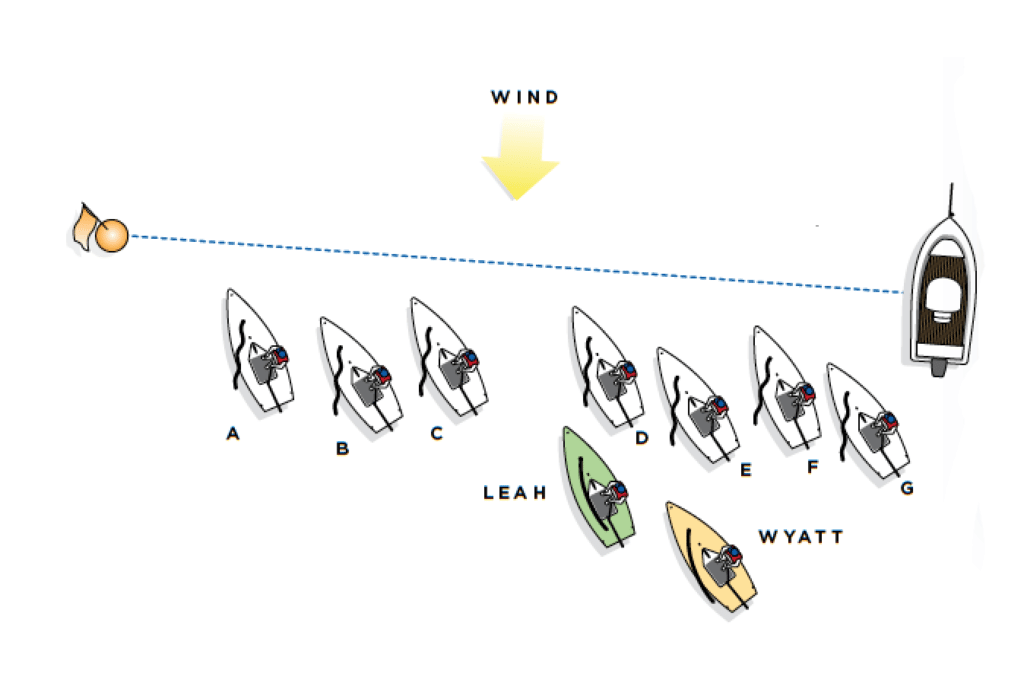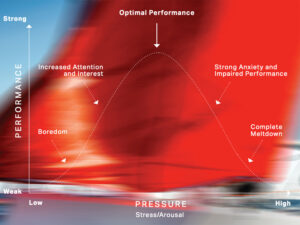
The rules definitely get their most intense workout between the preparatory signal and the starting signal. Boats are close together, frequently changing course, and often those course changes are difficult to anticipate. Yet provided that the starting-line marks are in open water, as they usually are, the rules are simplified during that four-minute stretch by a statement that many readers overlook: the preamble to Section C of the Part 2 rules. Section C contains the rules that apply at marks and obstructions. Its preamble states, “Section C rules do not apply at a starting mark surrounded by navigable water or at its anchor line from the time boats are approaching them to start until they have passed them.” There are two ways in which that preamble significantly simplifies the rules during the pre-start.
You can forget about Rule 18 (mark-room, and the zone around a starting mark) from the time you start your final approach to the line to start until you have left that mark behind after the starting signal. This tremendously simplifies the rules when you start near one end of the line.
Rule 20 (room to tack at an obstruction) does not apply at a starting mark when boats are on their final approach to start. This means that, if a starting mark is large enough to be an obstruction, a boat is not entitled to hail another boat under Rule 20 for room to tack at that obstruction. Of course, if the mark were a buoy too small to be an obstruction, Rule 20 would not apply. So the starboard-tack boat nearest to the port-end starting mark may never hail for room to tack as she approaches that mark. Imagine the chaos she could cause if she could hail.
Note that even before boats begin their final approach to the line to start, Rule 18 does not apply at a starting mark. This is so because, as Rule 18.1 states, Rule 18 only applies when the boats are required to leave the mark on the same side, and, under Rule 28.2, starting marks do not have a required side until boats are on their final approach to the line.
What is often neglected in discussions of the starting-line rules is that Rule 19 (room to pass an obstruction) and Rule 20 sometimes apply during the pre-start interval. Those two rules apply only to three-boat incidents in which one of the boats (call her A) has right of way over the other two (call them B and C). In that situation, A is an obstruction to B and C (see the third sentence of the definition of obstruction). Here are examples of such incidents:
Example 1: Suppose A is just below the line on starboard tack with her sails luffing, and B and C are on port tack approaching A and intending to tack under A. If C is to leeward or just clear ahead of B, and B is blocking C from tacking, and if C is sailing closehauled or above and she needs to make a substantial course change to avoid A, C may hail B under Rule 20 for room to tack and avoid A. After C hails, B must give C room to tack, as provided in Rule 20.2.
Example 2: Suppose Boat A is on starboard tack reaching toward B and C, both of whom are on port tack. A is an obstruction to B and C. B and C are overlapped with C to leeward of B, so C has right of way over B under Rule 11. Rule 19.2(a) gives C a choice: C may choose to pass either to leeward or to windward of A. If C chooses to pass to leeward of A, then C is required by Rule 19.2(b) to give B room to pass between her and A. If C chooses to pass to windward of A, then B is required by Rule 19.2(b) to give C room to pass between her and A.
Examples 3 and 4: Let’s consider the two scenarios shown in the diagrams. With about 30 seconds to go until the starting signal, seven boats (A to G) on starboard tack are stalled just below the line on approximately closehauled courses with their sails luffing. They are all clear ahead and have right of way over the two boats coming up from astern. There is just one gap in the line from A to G. It is between C and D, and it is wide enough to accommodate one but not two boats. Each of the two boats coming up to the line from clear astern is hoping to be the one that sails into that gap. The two diagrams are quite similar, but the rules that apply to them are surprisingly dissimilar.

In the first diagram, Wanda and Lucas are overlapped, with Lucas having right of way over Wanda under Rule 11. Before Wanda becomes overlapped with boat D, both she and Lucas are required by Rule 12 to keep clear of D. During that time, D is an obstruction to Wanda and Lucas. Lucas is permitted by Rule 19.2(a) to pass the obstruction, D, on either side, but in order to sail into the gap, he has chosen to pass to leeward of D. While both Wanda and Lucas are still clear astern of D, Wanda is in the space between Lucas and D. For that reason, Rule 19.2(b) requires Lucas give Wanda room to pass between him and D, the obstruction.
When Wanda becomes overlapped with D, the applicable rules change: Lucas becomes overlapped with D because Wanda is between Lucas and D (see the fourth sentence of the definition clear astern and clear ahead; overlap); Rule 12 ceases to apply; Lucas and Wanda obtain right of way under Rule 11 over D, so D ceases to be an obstruction to Lucas and Wanda, and Lucas becomes an obstruction to Wanda and D; and initially Rule 15 requires both Lucas and Wanda to give D room to keep clear. There is not enough space for Lucas to sail into the gap and meet both his Rule 15 obligation to D and his obligation to keep clear of C (first under Rule 12, and, later, if he becomes overlapped to windward of C, under Rule 11). So Wanda is entitled to the gap between C and D.

In the second diagram, during the time before Leah becomes overlapped with D, Wyatt is never in the space between Leah and D. Therefore Rule 19.2(b) does not require Leah to give Wyatt room between her boat and D. When Leah becomes overlapped to leeward of D, she obtains right of way over D, and therefore D is no longer an obstruction to Leah and Wyatt. For those reasons, Rule 19.2(b) never applies between Leah and Wyatt. After Leah has begun to move into the gap between C and D, Wyatt is required by Rule 12 to keep clear of D, and by Rule 11 to keep clear of Leah. There is no way for Wyatt to move into the gap between C and D without breaking one of those two rules. Poor old Wyatt is hung out to dry. He must somehow slow his boat and sail astern of Leah, as well as C, B and A.
There is a lesson here. When two overlapped boats are competing for a narrow gap in a lineup of luffing starboard tackers, the boat entitled to sail into the gap will generally be the boat that is bow-out on the boat overlapped with her.
Final note: In those rare instances when one end of the starting line is on a dock or on shore, and therefore not surrounded by navigable water, the Section C preamble does not apply at that end of the line. This means that all the Section C rules apply on your final approach to that end.
Emails for Dick Rose may be sent to rules@sailingworld.com.









